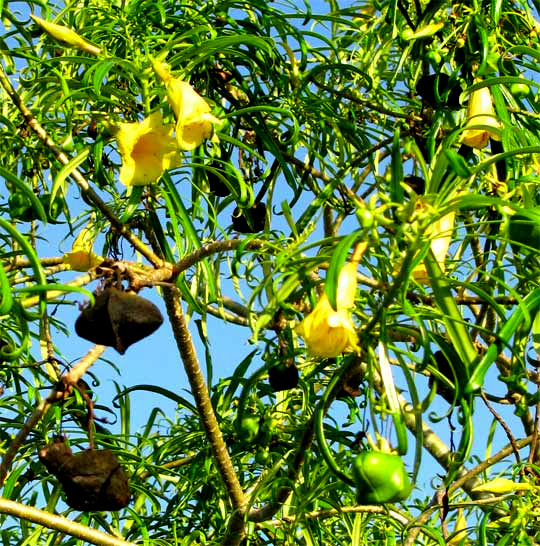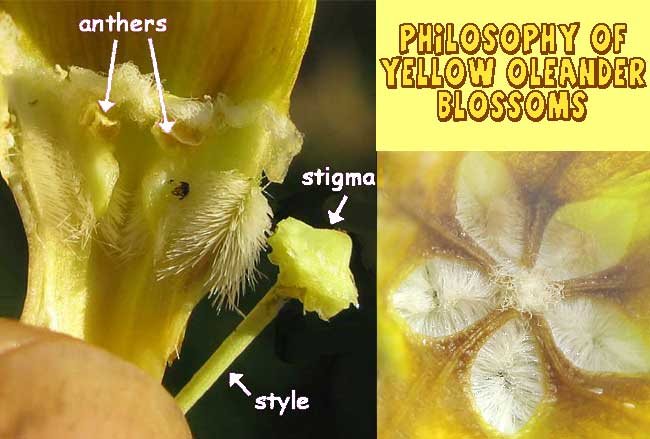Excerpts from Jim Conrad's
Naturalist Newsletter
from the September 15, 2008 Newsletter written in Sabacché and issued from a ciber in nearby Tekit, Yucatán, MÉXICO
YELLOW OLEANDERS FLOWERING
In towns large and small all across the Yucatán and the rest of tropical Mexico right now one of the most eye-catching flowering plants is the Yellow Oleander, THEVETIA PERUVIANA, whose yellow, 2.5-inch-long flowers, black fruits and willow-like leaves are shown below:

YELLOW Oleander is completely different from the Oleander in my backyard back in Chiapas (see here) The two oleanders belong to the same family, the Dogbane Family, or Apocynaceae, but they reside in entirely different genera. Yellow Oleanders bear one leaf at each stem node (they're alternate) and the fruit is the curious fleshy drupe in the picture, while the leaves of Oleanders, genus Nerium, mostly occur in groups of three, and the fruits are slender, okra-pod-like, dry fruits, or follicles, that open along one side when releasing seeds. One feature the two oleanders share, however, is that all parts of both plants are toxic.
Yellow Oleander's thick, four-sided, black fruit is really an unusual thing. It's green when immature, then turns bright, glossy red, and finally it becomes the dull black shown in the picture. Inside resides a smooth, brown stone sometimes called a "lucky nut." Enterprising natives have been known to string lucky nuts on necklaces, and to sell them as charms for carrying in the pocket.
Yellow Oleander's blossoms are large enough for us to easily see some of the flowers' basic anatomy, thus have the fun of figuring out why things are structured the way they are -- how its anatomy facilitates pollination.
Above we saw that Yellow Oleander flowers are funnel-shaped -- a narrow tube flares out above. The area where the narrow basal tube abruptly enlarges can be referred to as the "throat," and it's in the throat area where the Yellow Oleander flower manages its pollination strategy. A chart showing features of a flower's throat-area anatomy can be viewed below:

In that picture the inset at the lower right shows a kind of barrier across the top of the throat, looking down on the throat area. The larger image at the left shows the throat area in cross-section, with the female stigma and style repositioned to the right of the tube so you can see better other features of the blossom's throat. Normally the stigma and style reside in the very center of the throat and tube.
*Now imagine that you're a bug drawn into the funnel- shaped flower by its sweet fragrance. When you reach the throat you encounter the star-shaped barrier at the lower right. But the sweet odor attracting you issues through the star's "arms," for those "arms" are nothing but holes congested with soft hairs pointing inward toward the holes' center. Where the hairs meet in the center of each hole there's an opening a bug might shove through, so you do.
In the cross-section at the left the star-shaped barrier you just passed through is seen as the fuzzy "roof" at the top of the image, just above the labeled anthers. Once you've passed the barrier, you need to squeeze between the barrier and the hat-shaped stigma head. If you're carrying pollen from another flower, now is when you deposit it on the stigma head, thus accomplishing the first thing the flower wants you to do.
For, your pollen grains can germinate there, send their pollen tubes down through the long style, to the ovules inside the ovary at the flower's base. Once the male sex germ transported in the pollen tube unites with the female sex germ in the ovule, then begins the process of maturing the ovule into a seed, and the ovary into a fruit, and of course that's the flower's ultimate goal.
Once you're past the broad stigma head it's easy going the rest of the way down to the nectar, especially since the hairs below the star-shaped barrier all point downward, as clearly seen in the picture.
Once you have your nectar and you're leaving the flower, once again the throat area blocks you with all those downward-pointing hairs, this time poking you in the face. However, in the image at the left, notice the glossy, hairless bulges rising below each anther and between the tufts of downward-pointing hairs. Also note how downward-pointing hairs are absent below the bulges. In other words, you can avoid the downward- pointing hairs by entering one of five hairless "doors," then mounting the hairless mound your door leads to.
At the hairless mound's top you're blocked by the bottom of the stigma and have to squeeze between the mound and the stigma bottom to get out. Notice that the stigma's bottom is notched. These notches invite you to exit in particular places. It happens that the arrangement of hairs, stigma-bottom notches and bulges all oblige you to rake past a pollen-coated anther on the way out, and naturally that's the second job the flower wants you to do -- to carry its pollen to the stigma head of another blossom, so pollination can be repeated there.
Once you've scraped past the anthers it's just a matter of going through a star-arm hole like the one you entered, then flying to the next blossom.